Menus
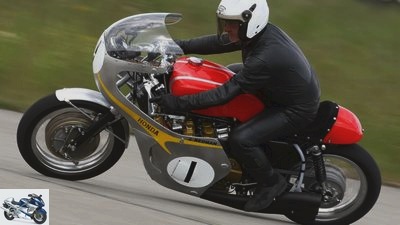
Jahn
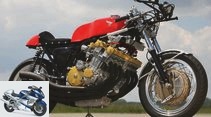
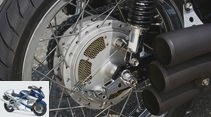
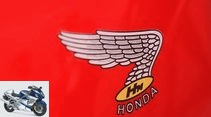
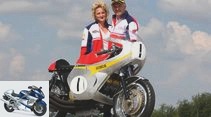
19th photos
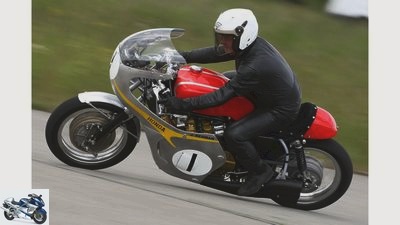
Jahn
1/19
Homemade: Honda CBX "RC166", A CBX 1000 served as the basis.
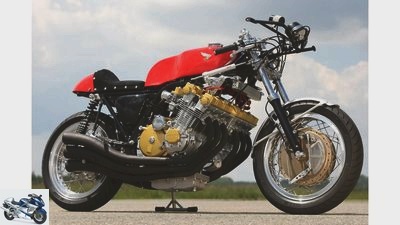
Jahn
2/19
Homemade: Honda CBX "RC166" without disguise.

Jahn
3/19
Ventilated drum brake of the Honda CB 750 – great looks, but modest effect. Megaphone trio with counter cone trimmed to the same length.
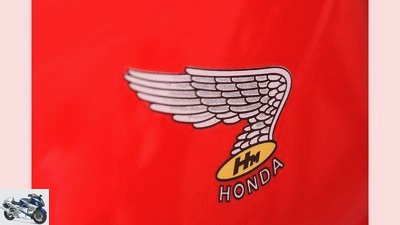
Jahn
4/19
Homemade: Honda CBX "RC166".

Jahn
5/19
Such a project needs support and patience – also from wife Ines.
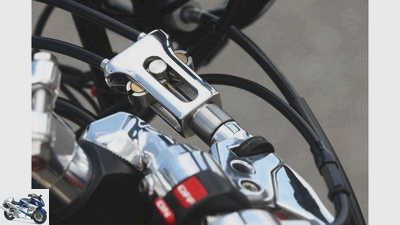
Jahn
6/19
Real craft: with a saw and a smoothing file, brake cable distributors carved from solid pieces on a balance beam.
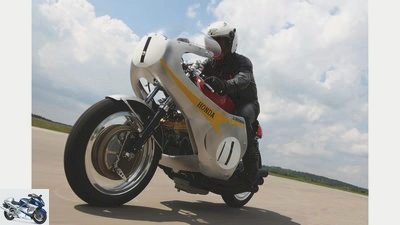
Jahn
7/19
It’s a shame that you can’t print this wonderful sound on paper.
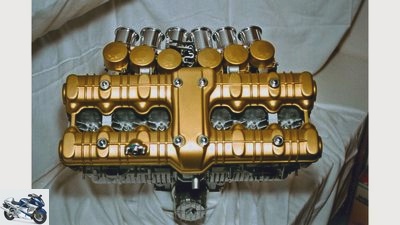
Jahn
8/19
With an overall width of almost 600 millimeters, the cylinder head determines the maximum dimensions of the Honda CBX engine with its central camshaft drive.

Jahn
9/19
Homemade: Honda CBX "RC166".
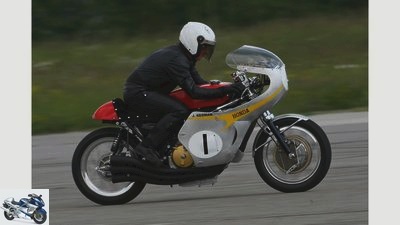
Jahn
10/19
With 130 hp at 230 kilograms, the CBX really marches forward in classic racing trim.
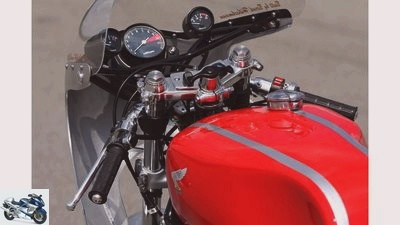
Jahn
11/19
The rev counter and the two round instruments sit on a sturdy subframe that has been elegantly hidden.
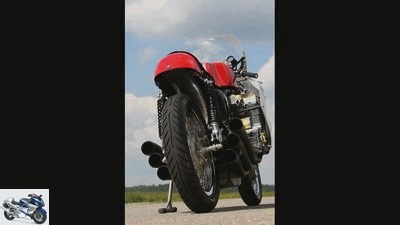
Jahn
12/19
This is where the music plays: a powerful wind orchestra with six powerful solo trumpets.
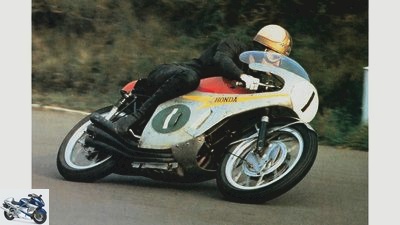
Jahn
13/19
In detail: This is how the Honda CBX “RC166” came about: Mike Hailwood with the original Honda RC166 at full speed.
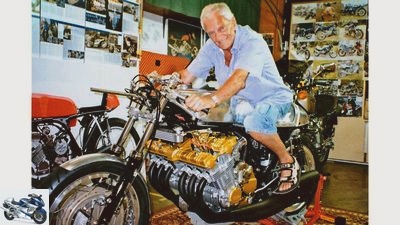
Jahn
14/19
Factory driver Jim Redman trying out Bernd Huebschmann’s CBX replica.
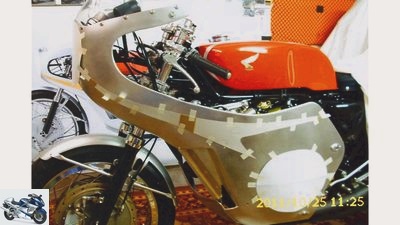
Jahn
15/19
Decorative stripes, start numbers and lettering were copied from the life-size RC166 (in the background) and transferred to the replica fairing.
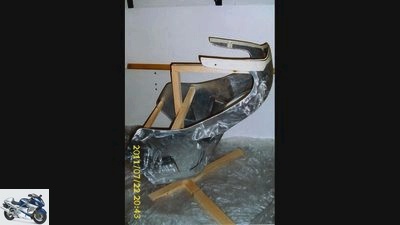
Jahn
16/19
Everything is handmade: the fairing, tank and mudguard are made from 1.5 millimeter thick aluminum sheets.
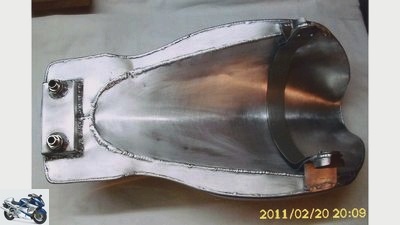
Jahn
17/19
Self-made tank also made of 1.5 millimeter thick aluminum sheet.
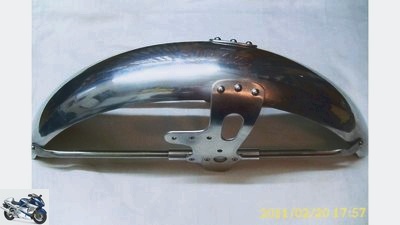
Jahn
18/19
Handcrafted apron.

Jahn
19/19
Homemade: Honda CBX "RC166". The entire project was implemented between April 2006 and September 2009.
250cc six-cylinder Honda from 1966
Homemade Honda CBX "RC166"
Content of
The legendary 250cc six-cylinder Honda from 1966 was the inspiration for Bernd Hubschmann’s replica based on the CBX 1000. A masterpiece of craftsmanship that drives as brilliantly as it looks. MOTORRAD Classic editor Werner Koch let the six-pack roar.
The test drives are hardly in progress, since the first complaint is already in the house. “We have a complaint about disturbance of the peace – although we have no noise limit”, the nice lady from the airfield in Neuhausen ob Eck apologizes. For many years, fighter jets darted low over the roofs, but when the CBX screeches from six open pipes down the runway, the doorbell rings a lot in the ears of some residents. “A few more laps, then we’ll have the photos in the can,” consoled the Classic editorial team and let the Honda off the leash. Not only because of the photos, but also because Bernd Hubschmann’s six-cylinder replica with its flawless chassis and a smoothly tuned engine is great fun.
Above all, it is the sound from half a dozen curved megaphones that makes the hair on the back of your neck stand up – and awakens memories. On May 22nd, 1966, when the second motorcycle world championship round of the year took place in Hockenheim. The Baden race track was the replacement for “our Solitude”, which was closed in the mid-1960s. It goes without saying that we, a handful of motorcycle-crazy teenagers who grew up less than 100 meters from the Solitude, made a pilgrimage to Hockenheim. The tiers were already packed early on Sunday morning, the vendor’s tray was doing good business with “racing rolls” and seat cushions when the Honda mechanics over in the paddock fired their 250 six-cylinder engines. What an unbelievable noise the RC166 roared into the wide area of the new Motodrom, a scream that literally tore apart the morning silence! Nobody was kept in their seats by the rhythmic barking of the gas. As if rooted to the ground, almost shocked, we heard the sound that the Japanese were firing around our ears and that no one should ever forget.
E.The 1000cc CBX engine flips through the rev range, something duller, but just as fascinating as the original. A fine throttle response at the very bottom of the speed cell is followed by a gentle hump of torque, which turns into surprisingly full thrust shortly before the five-digit range and pushes the replica, weighing around 230 kilograms, rapidly over the slope. Accompanied by a soundscape that almost tears your eardrum. Barking hoarse when braking with double-declutching, ominously rumbling when pulling out of the bends, crystal clear in all positions, without snarling nuances when the gears are stepped through at lightning speed – pure goose bumps!
The great thing about it: Bernd Hubschmann’s Honda replica immediately gives you a secure, confident feeling, suspension, steering geometry and balance harmonize perfectly. With solid damping, the Honda crosses transverse grooves and bumps even at a considerable incline, steers precisely, albeit a bit clumsy, and holds the chosen course as if pegged. This is not always the case with handmade one-offs. And astonishing because the basic structure and layout of the Honda bridge frame corresponds to the series CBX of the first year of construction (CB 1).
But the driving characteristics of the production Honda CBX 1000 were more than feared. What the CBX specialist Hubschmann already called on the plan with the first idea for his replica on a scale of around 1.2 to 1 (slightly larger than the original). Because the frame itself, in its layout very similar to that of the 250 factory machine from 1964, does not have any fundamental weak points. Of course, after the launch of the CBX 1000 in 1978, there was a lot of criticism of the simple but also relatively light bridge frame of the Honda. Especially since the competitors in the large displacement class usually screwed their powerful engines into closed double loop frames. A look at current sports machines, however, shows that Honda had put an ingenious composite concept on the wheels with the combination of an open frame and a load-bearing engine. At least in the large class, however, it was only years later that such constructions in the form of the so-called Deltabox chassis (Yamaha FZR 1000, 1986).
Jahn
This is where the music plays: a powerful wind orchestra with six powerful solo trumpets.
The problems with the early CBX 1000 were rather the thin 35-millimeter telescopic fork and the sometimes very generous bearing tolerances of the swing arm and steering head. In the case of the replica, bearing guru Emil Schwarz pressed them both backlash-free and into precisely cylindrical seats. Previously, the builder shrunk a steel ring over the upper seat in the steering head to prevent its oval expansion. The fork itself was taken from a Pro-Link-CBX, which is designed to be significantly stiffer at 39 millimeters. Springs together with the appropriate 15 hydraulic oil from Wilbers and low-friction surfaces through careful polishing give the fork the final touch. Hubschmann dispensed with the air support that was provided at the time, the progressively wound suspension springs are sufficient. Aft, the box swing arm was stiffened by means of a substantial addition of material, the horizontally halved and welded second swing arm body drastically improves the torsional and bending stiffness. Two Ikon suspension struts with progressively wound springs are supported on the shortened rear frame and complete the chassis treatment.
Bernd Hubschmann pursued the goal of copying his friend Jim Redmann’s RC166 as exactly as possible with meticulous precision.
A life-size photo of the factory machine served as a model for the RC166 replica. It shows the undisguised 250, from which many details have been copied. Everything, of course, a little bigger, a little more massive, but if it was technically feasible, it was exactly like the model. Doubt? Then take a look at the front fender. Born in the Vogtland, he even measured the size of the rivet heads and recreated them accordingly. Just as he copied the trim on the tank and fairing to scale. Even the number and positions of the panel screws are identical. Only the 1.5 millimeter aluminum sheet of the tank and paneling was not machined by Bernd Hubschmann himself, but rather had it shaped by Stefano Race. Adapted to the wide six-cylinder engine, the replica lacks the oil cooler installed on the left and right of the original. And almost a little embarrassed, the noble screwdriver confesses that the cladding of the first RC 164 factory machine (1964) was not made from 1.5 millimeter thick, but from extremely delicate 0.8 millimeter aluminum sheet. It was not until 1966 that the Japanese laminated their polyester panels. How does he know such subtleties? The legendary Honda factory mechanic Nobby Clark and Jim Redman told him that. Just like many other details that went into building his dream machine. The six-time motorcycle world champion is also totally enthusiastic about it. “Jim took a seat on the shell and smiled, perfect!”, Bernd remembers the visit of the now 80-year-old GP warrior two years ago at home in Oberstaufen, Bavaria.
There is a reason why the CBX six-cylinder has more in common with the 250cc factory machine, not only visually, but also technically than you might think. And his name is Shoichiro Irimajiri. The Japanese engineer was responsible for both machines. The high-volume six-cylinder, which came on the market twelve years after the RC166, should benefit from the legend and its world championship titles. With a 33 degree cylinder angle, piggyback positioned alternator and the filigree bridge frame open at the bottom, Honda demonstrated the clear derivation of the CBX 1000 from the legendary GP machines. So what was more natural for Bernd Hubschmann than to get down to work?
Jahn
With an overall width of almost 600 millimeters, the cylinder head determines the maximum dimensions of the Honda CBX engine with its central camshaft drive.
The impetus for this crazy idea was a 350 six-cylinder MV Agusta factory machine. When warming up for a demo drive, it took the CBX fan of the first hour (Bernd was one of the few Honda CBX drivers in the Eastern Bloc at the time) breathless. Afterwards there was no stopping: a classic racer like this had to go into the house, no matter what the cost.
In April 2006 he dismantled the six-transmitter and meticulously optimized its weak points. From top to bottom: HRC camshafts with 0.5 millimeters more stroke and greater overlap, pistons with greater compression height, valve seats and valves ground in.
With a lot of patience, the 24 channels were remodeled in a streamlined manner. The hand milling cutter hummed for three days to optimize the flow of the transitions and surfaces of the channels. Bernd Hubschmann chose a cylinder head from the Pro-Link series because its cast aluminum has proven to be more resistant to hairline cracks between the valve seat and the plug bore. On the lower floors of the six-cylinder engine, engine specialist Reinhard Scheuerlein took care of the perfect mass balancing of the crankshaft, which carries HRC steel connecting rods with absolutely identical weight and mass distribution on the polished crank pins. Deviations of up to five grams are not uncommon in the series. The robust gearbox of the Pro-Link series, including the improved shock absorber in the primary drive, also found its way into the renovated engine. And this the way into the revised chassis, which was perfectly painted and stood without any frills in 2009 on the pretty spoked wheels.
Now it was only a matter of tinkering with six stylishly curved exhaust pipes. At the latest at this task, even experienced metalworkers flinch. Two elbows with two megaphones – okay. Four elbows with four megaphones – that will be difficult. Six bends with six curved megaphones, the whole thing perfectly fitting and symmetrical – something for absolute experts. Matthias Kunz from Oelsnitz in Vogtland is the name of the man who made the exhaust system by hand. With great skill and even more talent for improvisation, the trained toolmaker adapted the six bags to the finished model. A masterpiece, wonderfully symmetrical and close-fitting, so that the self-made CBX just doesn’t scramble the work of art in an inclined position.
Bernd Hubschmann had carefully planned the launch of his RC166. On September 13, 2009, exactly 45 years after the spectacular premiere of the RC 164 in Monza, he swapped his work coat for a black jacket, opened a good bottle of bubbly and took his wife Ines to the workshop. There was the well-kept secret that was why Bernd had withdrawn every free minute into his catacombs. She must have guessed that something was brewing that would challenge the whole guy. She never dreamed that her spouse would put a deceptively real replica of the RC166 on the wheels. Let’s be honest: Most Classic readers would hardly have thought such a project from a private initiative possible – or would they??
Jahn
Such a project needs support and patience – also from wife Ines.
When asked about the costs, the builder only rolls his eyes. Of course, the project would not have been so successful without the many helpers and accomplices. Again and again, a case of beer or a bottle of Italian red was due – the usual means of payment in the scene. For a few urgent milled parts, quick painting work or other urgent assistance.
As always, when a large construction site drags on for years, not only money but also a lot of time have to be invested. “Roughly 1000 hours, 150 hours of which were spent just for the engine overhaul with painting.” With around 55,000 euros in material costs and external services, the CBX replica is one of those dreams that one cannot often afford. “A second time,” says Bernd Hubschmann, “I wouldn’t tackle a project like this again.” What a shame!
Conversion information
Jahn
Homemade: Honda CBX "RC166". The entire project was implemented between April 2006 and September 2009.
Conversion info
As a proven CBX expert, Bernd Hubschmann overhauled the entire engine himself. He is also happy to receive inquiries about CBX engines or complete conversion work. When adjusting the carburettor to the open funnel and the 6-in-6 exhaust system, he expanded the primary nozzle from size 65 to 70, the secondary nozzle from 98 to 110, while the idle nozzle (35) remained unchanged. The oil cooler and the reinforced cylinder studs in the engine block come from a Pro-Link engine. A milled intermediate ring on the oil pan increases the amount of oil that is sucked into the oil pump by a longer snorkel. After glass bead blasting, he colored the motor housing and the golden yellow cover with temperature-resistant RH motor paint (www.motorradlack.de).
In order to get a stable screw connection of the brake anchor for the 250 drum brake, Bernd simply swapped the dip tubes of the CBX fork from left to right, cut the lower aluminum eye of the brake calliper attachment and screwed the two retaining plates to the upper eye.
The entire project was implemented between April 2006 and September 2009. But it wasn’t until the spring of 2012 that the CBX grumbled in full regalia about a disused airfield course. Anyone who is interested in the spectacle for the eyes and ears can be helped. Bernd Hubschmann also likes to do a few demo laps on his CBX replica at events and meetings. However, one should get the blessing of the local residents beforehand. Because when the 1000 engine roars from all six open pipes, the cups fly out of the cupboard.
Contact: Bernd Hubschmann, Oberstaufen, phone 01 77/6 22 48 31, berndhuebschmann@googlemail.com
Jahn
Everything is handmade: the fairing, tank and mudguard are made from 1.5 millimeter thick aluminum sheets.
Machining crankshaft:
Reinhard Scheuerlein, 91522 Ansbach,
www.scheuerlein.de, phone 09 81/1 75 54
Aluminum parts: Stefan Woerlen,
84056 Rottenburg, www.alutank.de,
Telephone 0 87 81/4 37 93 67
Swing arm bearing: Emil Schwarz,
73660 Urbach, www.emilschwarz.de,
Telephone 071 81/99 52 90
Seat cushion: Hubert Klotz,
88239 Wangen, phone 0 75 22/2 89 47
Engine paint: RH-Lacke GmbH,
27239 Twistringen, www.motorradlack.de, phone 0 42 43/20 88
Paint companies: Michael Lingg,
88167 Stiefenhofen / Allgau, phone 0 83 83/92 99 73
design: Uwe Ruschinski,
87534 Oberstaufen, www.werbemanufaktur-allgaeu.de, phone 0 83 86/96 97 23
Honda CBX “RC166”
Jahn
Decorative stripes, start numbers and lettering were copied from the life-size RC166 (in the background) and transferred to the replica fairing.
engine:
Air-cooled six-cylinder in-line engine, two overhead camshafts, four valves per cylinder, actuated via bucket tappets, displacement 1047 cm³, bore x stroke 64.5 x 53.4 mm, approx. 130 hp at 9500 / min, max. Torque approx. 86 Nm at 8200 rpm, six 28 mm constant pressure carburetors, enlarged oil pan (6.5 liter capacity)
Power transmission:
Primary drive via inverted tooth chain and countershaft, multi-disc oil bath clutch, five-speed gearbox, secondary drive via roller chain
landing gear:
Tubular steel bridge frame open at the bottom, telescopic fork, Ø 39 mm, reinforced two-arm swing arm made of square steel profiles, spring travel front 140, rear 100 mm, wire-spoke wheels with Akront high-shoulder rims, front 2.50 x 18, rear 3.00 x 18, front tires 100/90 V 18 , rear 130/70 V 18, 250 mm double duplex drum brake in front (Fontane copy), 180 mm simplex drum brake in rear
Measurements and weight:
Wheelbase 1545 mm, steering head angle 62 degrees, weight with a full tank approx. 230 kg
Related articles
-
Sauquet 33 photos Sauquet 1/33 Sauquet 2/33 Sauquet 3/33 Sauquet 4/33 Sauquet 5/33 Sauquet 6/33 Sauquet 7/33 Sauquet 8/33 Sauquet 9/33 Sauquet 10/33…
-
VF 1000 F2 self-made Honda V4 exit
www.factstudio.de 8 pictures factstudio.de 1/8 picture gallery: Honda V4 exit. factstudio.de 2/8 V4 Hondas in all variations: From the noble VF 1000 …
-
Honda CB 1100 R, Honda VF 1000 R in the test
Jahn 16 photos Jahn 1/16 Athletes in tails – a comparison of the two long-distance racers from the Honda brand. Jahn 2/16 A very fine detail borrowed…
-
On the move with the Honda CB 900 F Bol d‘Or, Honda CBX, Kawasaki Z 1000 ST and Kawasaki Z 1300
Arturo Rivas 45 photos Arturo Rivas 1/45 Six against four for the first: Honda CBX and Honda CB 900 Bol d’Or. Arturo Rivas 2/45 Honda CBX. Arturo Rivas…
-
Photos: fact 11 photos Honda 1/11 Honda CBR 600 F. Honda 2/11 Honda CBR 600 F. Honda 3/11 Honda CBR 600 F. Honda 4/11 Honda CBR 600 F. Honda 5/11 Honda…
-
On the move: Honda VF 1000 R, Kawasaki GP Z 900 R, Suzuki GSX-R 1100
Jahn On the move: Honda VF 1000 R, Kawasaki GP Z 900 R, Suzuki GSX-R 1100 Technical revolution Content of They drove us crazy – and saved us money:…
-
Driving report: the retro bike Honda CB 1100
Yamada 12 pictures Yamada 1/12 The flap in the exhaust of the Honda CB 1100 is also state-of-the-art. Yamada 2/12 Classic and yet …
-
Technology highlights: Bimota Tesi, Honda NR 750, Norton TT
Jahn Technology highlights: Bimota Tesi, Honda NR 750, Norton TT Techno motorcycle The pace of further development in two-wheelers is getting faster and…
-
On the move: Honda CB 750 Cafe Racer
Jahn 13 photos Jahn 1/13 Owner Peter Wolf can rightly be happy about his cream piece. Jahn 2/13 Two generations of Honda: Honda CB 750 Cafe Racer and…
-
Honda CBR 1000 RR Fireblade 2012
Honda 16 photos Youtube 1/16 Honda CBR 1000 RR Fireblade 2012 Youtube 2/16 Honda CBR 1000 RR Fireblade 2012 Youtube 3/16 Honda CBR 1000 RR Fireblade 2012…